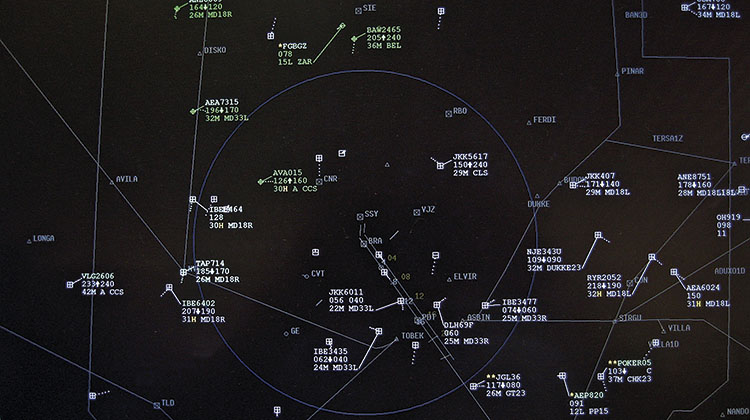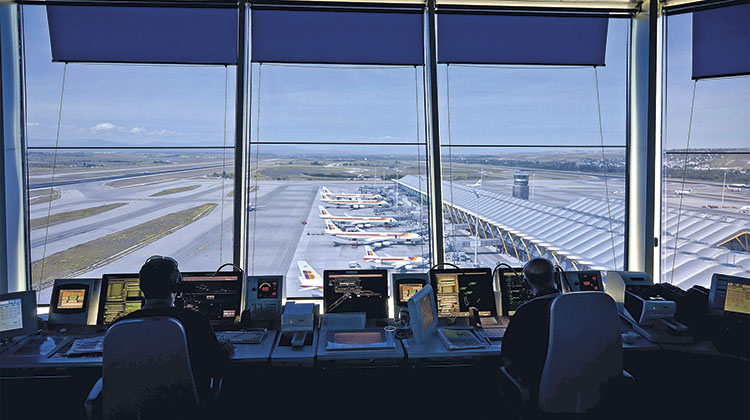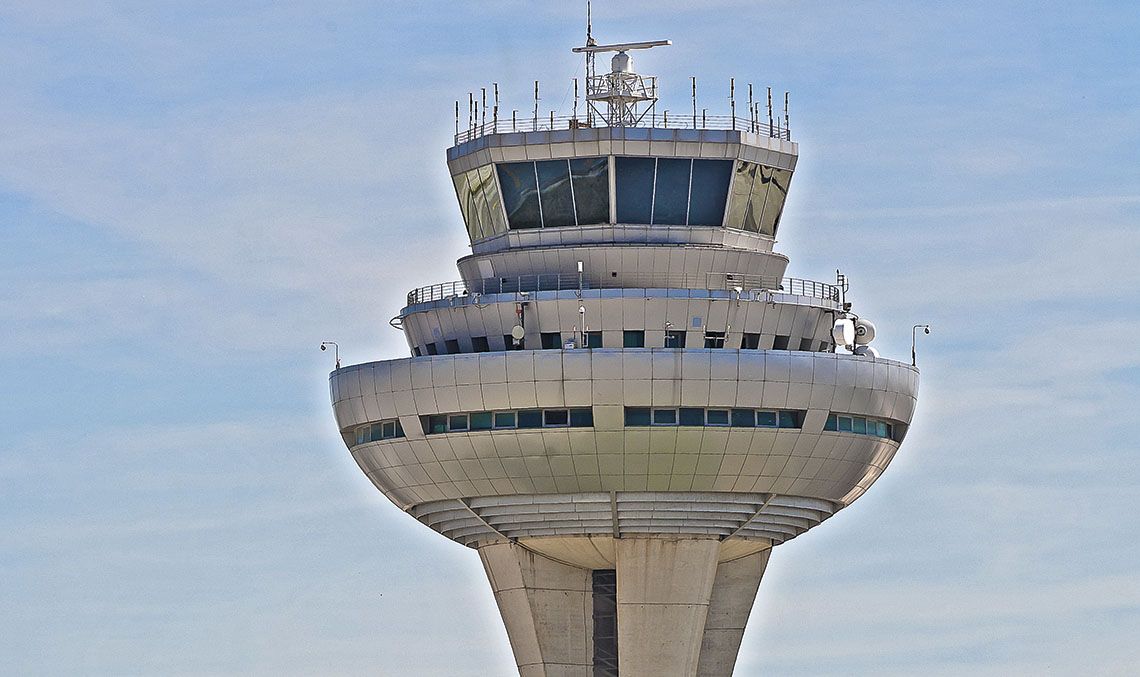ENAIRE’s automatic air traffic control system (SACTA for its acronym in Spanish), is a complex system of local machines and servers, installed in control centres and towers, that share information in real time. SACTA makes it possible to automate the acquisition, processing, distribution and presentation of the data required to carry out air traffic control tasks that form part of the air traffic management (ATM) system. The main objective of ATM is to regulate traffic in a secure and orderly fashion, as well as to ensure that air navigation system capacity can meet the demand. SACTA began providing service in 1990 at Palma de Mallorca’s control centre; nowadays it is the only traffic control system in all of Spain’s airports.
This system carries out the integration, automation and improvement of processes which allow for the control of aircraft that are en route, approaching and near the tower. In this way, information can be coherently processed and the associated air traffic control and management services have the support they need to meet security and service objectives. It is an ever-evolving system, meaning that ENAIRE is constantly perfecting and modernising it.
Ineco has collaborated with ENAIRE since 1998 on the evolution of SACTA, as well as on the automatic system for flight plan, aeronautical and meteorological information (ICARO), by participating in the specifications, design, testing and commissioning of new functionalities. Ineco’s experts are part of system evolution and development in almost all areas, from the design of both functional and hardware architecture requirements, to maintenance and assistance to different ENAIRE users. A broad range of ATM system knowledge is obtained this way, proving extremely useful to the company and facilitating its national and international expansion.
Broadly speaking, the SACTA system makes it possible:
- To provide the controller with all relevant, updated air traffic data, thus facilitating interoperability between control facilities, collateral installations in Spain and abroad, and the CFMU.
- For controllers and technicians to receive training in a dynamic simulation environment.
A modular, redundant design was chosen to deal with such a complex system, thus allowing it to evolve with the least possible disruption to the operation.
Information that is always available to air traffic
The SACTA system, via its subsystems, integrates and provides the following information which is available to air traffic controller at all times:
- Flight plan information: the system is in charge of processing the flight plans received, determining routes and flight profiles. It also guarantees the interoperability of control facilities and foreign agents, making them fully compatible with flight plans that have origins and/or destinations beyond Spain’s borders.
- Flight monitoring: the system makes it possible to identify and obtain the position and information regarding aircraft trajectories in controlled airspace, as well as the capacity to ensure the separation and controlled flow of flights. This information is obtained by integrating data from the radar and sensor network for position within national territory, with the data provided by each aircraft in real time.
- Aeronautical and meteorological information: the system receives and processes meteorological and aeronautical messages (such as SMI, QNH and NOTAM).
- Supervision: the purpose of the system is to monitor, control and configure the HW/SW subsystems, which make up the SACTA system, thus promoting its reliability and integrity.
- Recording and operations: these allow for the analysis and study of operational and technical information.

SACTA SCREEN. The SACTA system determines routes and flight profiles, identifies the position of aircraft and ensures their separation in airspace.
New functionalities
Greater capacity, precision, savings and efficiency
The main purpose of SACTA, as an ATM system in service, is traffic security in all airspace sectors, thus the reason why it is constantly evolving. The automation of processes which are increasingly complex due to the high concentration of flights in European skies is organised, developed and tested alongside ATC personnel. This makes the information received by air traffic controllers through their HMI (Human Machine Interface) accurate and relevant, thus improving and strengthening communication flows with aircraft and different subsystems. The latest SACTA development included a series of functionalities which noticeably improve efficiency in route control, TMA and TWR. Below are the details concerning the most important changes currently being implemented:
- Paperless Operations (OSF for its acronym in Spanish).The flight progress strip is a fundamental tool for air traffic controllers. This little slip of paper contains the essential information about the route or itinerary for each controlled flight. With the use of ‘paperless operations’, aerodrome control management is possible with electronic flight strips. These strips appear on the screen in the same order as the old strips which were organised in bays. This system did not simply replace paper, but it had to be adapted to the different roles performed by tower controllers. Management of traffic in the tower is divided into three different areas of responsibility: Clearance (ATC authorisation and start-up), taxi track (taxi clearance) and Local control (clearance for takeoff and landing); these areas of responsibility can be assigned individually, or several can be integrated into a control position. Accordingly, for each case the electronic flight strip presented will follow its functional cycle in line with the areas of responsibility assigned to each control position. Implementation of paperless operations (OSF), presently at Palma de Mallorca and Malaga airports, immediately resulted in increased efficiency and capacity.
- Air Ground DataLink (AGDL). AGDL implements land-air point-to-point digital communication, allowing for the exchange of information between the aircraft and the Control Centre regarding two different technologies: ATN and FANS. Among other amenities, it provides ADS-C and CPDLC services. Implementation of ADS-C (Automatic Dependent Surveillance–Contract), only in the FANS network, represents significant progress in surveillance. It generates periodic reports or variables on request such as aircraft position and speed, using available aviation information as the source, including GPS data. CPDLC technology (Controller-Pilot Data Link Communication) consists in exchanging a series of pre-defined text messages based on a common phraseology between the air traffic controller and the pilot. This technology makes it possible, among other benefits, to accelerate operating instructions and prevent confusion caused by voice dialogues, thus a complementary tool to this technology.
- Collaborative Decision Making (CDM). The CDM project is an operational efficiency improvement tool whose approach is the process of aircraft rotation, based on the philosophy of sharing information that affects flights, among the different actors involved (handling, control, airlines and airport). This information is processed, thus increasing its accuracy and completeness. Reduced wait times and increased efficiency are achieved with this tool. The CDM process involves adapting the procedures that the airport operates with.
- Arrival Manager (AMAN). The Arrival Manager implements calculation of the optimal airport arrival sequence by utilising efficiency criteria to reduce wait times, thus facilitating flight transfer between APP and TWR.
- eCOS/eVEREST. Although it is almost at the end of the list, it represents the most important change in the evolution of system hardware and software in recent years. It involves a redistribution of the system’s core information nodes, thus affecting the overall architecture of the system. It goes from a configuration where the Seville and Palma servers are integrated, in a centralised manner, in Madrid and Barcelona respectively, together with their affected TWR facilities. The impact on the distribution of flight plan, radar, aeronautical and meteorological information is global, but the costs for implementation, commissioning, maintenance and development are reduced. Although it is a big change to the infrastructure, it is not a big change for normal control operations, meaning that it is transparent.
- Phase 2 Configuration (CF2 for its acronym in Spanish). CF2 affords easier operations, based on the aircraft tag that the air traffic controller sees on the screen. This tag displays colour changes or blinking on a global level or in certain fields, some of which are new, depending on the status of the flight plan, transfers between sectors, restrictions and alerts.

The main purpose of SACTA, as an ATM system in service, is to provide the tools which make it possible to guarantee the separation of traffic in all airspace sector. / PHOTO_PABLO NEUSTADT






